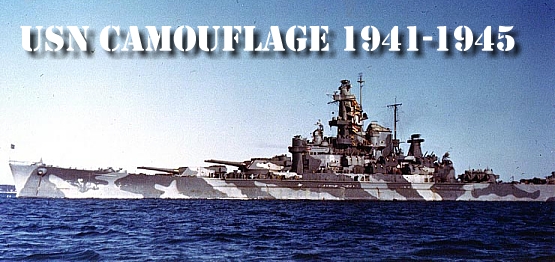The
Development of Naval Camouflage 1914 – 1945
Part III: British Camouflage in World War II
By
Alan Raven
(Article
reprinted courtesy of Plastic Ship
Modeler Magazine issue #97/1)
AMERICAN
WESTERN APPROACHES TYPE
Originated
from American Bureau of Ships.
Used
by most American built destroyer escorts upon delivery to the Royal Navy in the
1943/44 period.
Colors
used: SL Light Gray, SS Sea Blue, and white.
Decks:
20B Deck Blue (revised). Masts and topmasts: White.
Countershading:
As per 1942 Western Approaches type.
1943
ADMIRALTY LIGHT DISRUPTIVE TYPE
Official
in origin.
In
widespread usage during 1943 and into the first part of 1944.
Colors
used: G10, B15, G20, B30, G45, and B55.
Decks:
Steel areas are painted G20, Areas of wood, semtex, corticene, and asphalt are
left in their natural co1or.
Other
horizontal surfaces: 1’hese should be painted 1/2 the reflection factor of
adjacent surfaces (see table).
Athwartship
vertical surfaces: Same color as adjacent vertical surfaces, except rear of
bridge, where the lightest color of the design should be used.
Countershading:
As per 1942 Admiralty Light Disruptive type.
Masts:
White topmasts. Remainder of mast should be the same as adjacent surface.
1943
ADMIRALTY INTERMEDIATE DISRUPTIVE TYPE
Official
in origin.
Used
on certain ships in 1943 and into 1944.
Colors
used: GS, G10, B15, G20, B30, G45, and BSS.
Decks:
Bare steel areas are G10. Semtex, corticene and asphalt are left their natural
color. Where wood decks became bleached, they should be painted a color that was
1/2 the reflectance factor of the design on the ships side.
Other
horizontal surfaces: Painted 1/2 reflectance factor of adjacent surfaces (see
table). Athwartship vertical surfaces: Use same color as adjacent surface,
except rear of bridge, where the lightest color of the design is to be used.
Countershading:
As per 1942 Admiralty Dark Disruptive type. Masts: As per 1943 Admiralty Light
Disruptive type.
1943
ADMIRALTY DARK DISRUPTIVE TYPE
Official
in origin.
Used
by a few ships during 1943 and into 1944.
Colors
used: GS, G10, B15, G20, B30, and G45.
Decks:
Bare steel areas were GS, remainder as per 1943 Admiralty Intermediate
Disruptive type. Other surfaces: As per Intermediate type.
Athwartship
vertical surfaces: As per Intermediate type. Masts: Topmast G45, remainder same
as adjacent surface.
ADMIRALTY
EMERGENCY TYPES (camouflage without pattern)
Semi-official
in origin.
Western
Approaches Type: All weather work is white, except band right round ship from
waterline to halfway up to Foc’s’le deck, shade
is G20.
Light Type:
All weather work is G45, except band right round ship from waterline to halfway
up to foc’s’le deck, shade is 620.
Intermediate
Type: All weather work is G20, except band right round ship from waterline to
halfway up to Foc’s’le deck, shade is G10.
Dark
Type: All upperworks are G20. Whole of hull is G10.
Countershading:
As for appropriate Disruptive type.
Decks:
As per appropriate Disruptive type.
SPECIAL
F.MERGENCY FLEET DESTROYER SCHEME
Official
in origin.
Used
by some fleet destroyers of the ”0” and ”P” classes from mid 1942, and
then by other fleet destroyers as they entered service.
Colors
used: G20, B30, G45, and white.
Decks:
As per 1943 Light Disruptive type.
Other
horizontal surfaces: As per 1943 Light Disruptive type.
Countershading:
As 1942 Light Disruptive type.
ADMIRALTY
STANDARD SCHEMES
1.
Battleships, cruisers, aircraft carriers, fleet destroyers, minesweepers,
monitors, and auxiliaries on any station - Scheme A.
2.Vessels
as above on Home and Mediterranean station in winter only - Scheme B.
3.
Destroyer escorts (including HUNT class) corvettes, sloops, and frigates on Home
and West African stations - Scheme C.
4.
Vessels in 3. above on all other stations - Scheme. D.
5,
Motor minesweepers, Including BYMS type) netlayers, and fleet tugs on any
station – Scheme D.
6.
Coastal craft, including MTB, MGB, ML, HDML, RML, MASB, and SGB types on foreign
stations - Scheme F.
7.
Vessels as in 6. above on Home stations – Scheme E.
8.
Landing craft on any station - Scheme G.
9.
Operational training submarines on home stations - Scheme H or dark grey at the
captain’s discretion.
10.
Vessels in 9. above on foreign stations – black, very dark blue (PB10), grey,
or green - Scheme. J.
11.
Anti-submarine training submarines on any station - as per Scheme J.
12.
All vessels not included above on any station - Dark Grey (G10) or Light Grey
(G45) - Scheme K. Note: Schemes E, F, G, H, and J used a disruptive patterned
camouflage.
ADMIRALTY
STANDARD TYPE
Official
in origin (Schemes A and B).
Scheme
B used in winter months only, on Home and Mediterranean stations, worn after
November and changed to Scheme A before May.
Colors
used: (Schemes A and B)
Scheme
A - Rectangular panel B20, remainder of weather work G45.
Scheme
B - Rectangular panel 830, all other weather work BSS.
Instruction
for painting to Schemes A and B:
1.
Camouflage to finish at top edge. of boot topping.
2.
Topmasts - paint white.
3.
Decks. Bare steel areas are B15. Wood, semtex, corticene, and asphalt are left
in their natural colors.
4.
Where minesweeping davits are carried, one should be painted white, the other
820 or B30.
5.
Countershading: As per 1943 Light type.
Scheme
C
Colors
used: Hull panel B55, remaining weather work white.
Instructions
for painting Scheme C:
1.
Camouflage taken to waterline over boot topping.
2.
Decks: As per Schemes A and B.
Scheme
D
Colors
used: 1Iull panel G45, all other weather work B55.
Instructions
for painting Scheme D:
1.
Camouflage taken to waterline over boot topping.
[ Back Page ] [ Home ] [ Table of Contents ] [ Next Page ]
| 